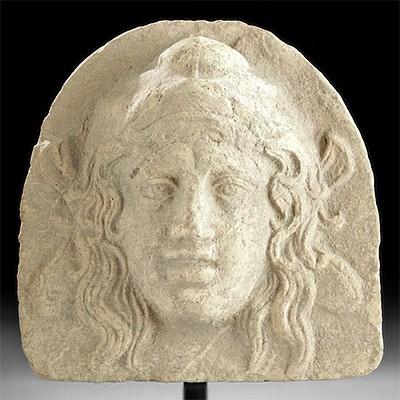Greek Apulian / Canosan Ceramic Patera with Swan
Lot 46
About Seller
Artemis Gallery
686 S Taylor Ave, Ste 106
Louisville, CO 80027
United States
Selling antiquities, ancient and ethnographic art online since 1993, Artemis Gallery specializes in Classical Antiquities (Egyptian, Greek, Roman, Near Eastern), Asian, Pre-Columbian, African / Tribal / Oceanographic art. Our extensive inventory includes pottery, stone, metal, wood, glass and textil...Read more
Categories
Estimate:
$2,500 - $3,000
Absentee vs Live bid
Two ways to bid:
- Leave a max absentee bid and the platform will bid on your behalf up to your maximum bid during the live auction.
- Bid live during the auction and your bids will be submitted real-time to the auctioneer.
Bid Increments
| Price | Bid Increment |
|---|---|
| $0 | $25 |
| $300 | $50 |
| $1,000 | $100 |
| $2,000 | $250 |
| $5,000 | $500 |
| $10,000 | $1,000 |
| $20,000 | $2,500 |
| $50,000 | $5,000 |
| $100,000 | $10,000 |
| $200,000 | $20,000 |
About Auction
By Artemis Gallery
Feb 27, 2020
Set Reminder
2020-02-27 10:00:00
2020-02-27 10:00:00
America/New_York
Bidsquare
Bidsquare : VARIETY SALE | Antiquities & Ethnographic Art
https://www.bidsquare.com/auctions/artemis-gallery/variety-sale-antiquities-ethnographic-art-4920
Around the world & back in time - be amazed at the treasures you will find. Antiquities from Egypt, Greece, Italy and the Near East, Asian, Pre-Columbian, African / Tribal / Oceanic, Native American, Spanish Colonial, Russian Icons, Fine Art, much more! Artemis Gallery info@artemisgallery.com
Around the world & back in time - be amazed at the treasures you will find. Antiquities from Egypt, Greece, Italy and the Near East, Asian, Pre-Columbian, African / Tribal / Oceanic, Native American, Spanish Colonial, Russian Icons, Fine Art, much more! Artemis Gallery info@artemisgallery.com
- Lot Description
Magna Graecia, Apulia, Canosan Hellenistic Period, ca. late 4th to 3rd century BCE. Quite sizeable and elegantly decorated, a beautifully preserved patera (phiale), a shallow bowl for libations. A graceful swan adorns the tondo - portrayed here as if floating on water though poised to take flight at any given moment, with its wings partially raised, its neck dipped in a tight curve and its broad feet tucked beneath it. The vessel is supported by an attractive tiered pedestal base. Twin handles flanked by spool-shaped knobs rise from the broad, flat rim. A vessel like this example was created especially for funerary purposes. Size: 15.25" W x 5.75" H (38.7 cm x 14.6 cm)
The iconography of this patera gives us an insight into popular religious beliefs in Magna Graecia. The swan played a complex role in Greek mythology - as the attribute of Aphrodite and Apollo, said to sing a song of unearthly beauty as it died, and as the form assumed by Zeus to ravish Leda, mother of Helen of Troy.
Canosa, or Canosion as it was known then, was a major center of the ceramics and pottery trade when it was a Greek polis. The Canosans created truly unique pottery, completely different in decoration style (though similar in form) from earlier and neighboring traditions. The clay body of Canosan pottery is buff, the decoration applied directly to it without the use of slip. The entire body was covered with white slip, with a second ground of pink color applied over the background where designs have not been drawn.
Provenance: private East Coast, USA collection; ex-Artemis Gallery; ex-private New Jersey, USA collection; ex-private Connecticut, USA collection, acquired in the 1980s
All items legal to buy/sell under U.S. Statute covering cultural patrimony Code 2600, CHAPTER 14, and are guaranteed to be as described or your money back.
A Certificate of Authenticity will accompany all winning bids.
We ship worldwide and handle all shipping in-house for your convenience.
#149752One knob is missing and handles likely reattached. Expected surface wear commensurate with age with normal pigment wear/loss, but most of the decorative program remains strong with well-preserved motifs. Liberal deposits grace the surface.Condition
- Shipping Info
-
All shipping is handled in-house for your convenience. Your invoice from Artemis Gallery will include shipping calculation instructions. If in doubt, please inquire BEFORE bidding for estimated shipping costs for individual items.
-
- Buyer's Premium



 EUR
EUR CAD
CAD AUD
AUD GBP
GBP MXN
MXN HKD
HKD CNY
CNY MYR
MYR SEK
SEK SGD
SGD CHF
CHF THB
THB















